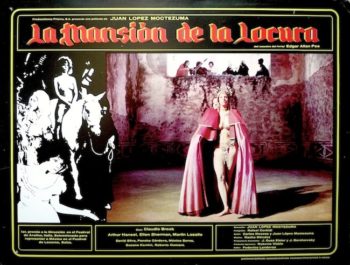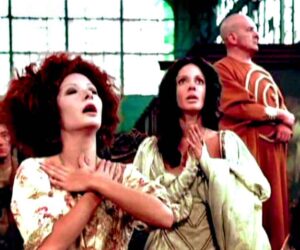This phantasmagoric spectacle, loosely based on Edgar Allen Poe’s story “The System of Doctor Tarr and Professor Fether,” remains a landmark of Mexican horror/fantasy. It was one of two surreal masterpieces created by the late, great Juan Lopez Moctezuma, a towering filmmaker whose likes we probably won’t be seeing again.
The other masterpiece mentioned above was 1978’s ALUCARDA, which represented the pinnacle of Juan Lopez Moctezuma’s peculiar genius. That’s not, however, to take anything away from THE MANSION OF MADNESS (LA MANSION DE LA LOCURA), his directorial debut. Prior to that Moctezuma was part of the “Panic” movement created by Alejandro Jodorowski and Fernando Arrabal. The three would collaborate on Jodorowski’s 1967 adaptation of Arrabal’s play FANDO AND LIS, which Moctezuma produced (although, contrary to what quite a few film guides mistakenly allege, Moctezuma did NOT produce Jodorowski’s subsequent EL TOPO). The experience is evident in THE MANSION OF MADNESS, which has a definite Jodorowskian flavor—unsurprisingly, Moctezuma utilized Jodorowski’s stock cinematographer Rafael Corkidi. It was, alas, poorly received in its native country and shunted onto the drive-in circuit in the U.S. (where it was retitled DR. TARR’S TORTURE DUNGEON–see below). Hopefully now, with the release of Mondo Macabro’s new DVD version, this shamefully neglected classic will finally get the respect it deserves.
Sometime in the Nineteenth Century, Gaston, a newspaper reporter, travels to a secluded insane asylum to do a story on the unorthodox methods of treatment utilized by its eccentric proprietor Dr. Raul Fragonard; Gaston has unwisely brought said proprietor’s daughter and a mutual friend along for the ride. Things get weird almost immediately, as the three arrive at the gates of the asylum and are accosted by gun-toting guards. Gaston ventures into the establishment but his friends decide to turn back, the previous confrontation having been too much for the lady’s fragile nerves; unfortunately for her, she and her companion are immediately waylaid and subjected to all manner of indignity by some seriously deranged men.
Gaston meanwhile meets up with Dr. Fragonard, who gives him a guided tour of the place, a labyrinthine establishment whose insane charges, working under the doctor’s “soothing” system, are encouraged to act out their neuroses. By-products of this system include a bizarre religion courtesy of a bald guy wearing a red cloak with a spiral design on it, a feathered man who thinks he’s a chicken and several emaciated men crucified in the basement, victims of the “less soothing” aspects of the doctor’s system. Understandably bewildered by all he’s seen, Gaston decides to escape and, gathering together his captive traveling companions, attempts to sneak out of the place…but ends up captured. It’s around this time that the “secret” of the asylum (which any attentive viewer should have already figured out) is finally revealed: Fragonard is in fact an inmate who together with his fellow charges has taken over the place and locked the real doctors in the dungeons. Gaston and his companions are put on trial in a vast enclosure where the asylum’s patients gather together to decide the verdict, which, as you might guess, is fairly severe.
THE MANSION OF MADNESS is an exercise in unfettered insanity, so be aware that there’s very little narrative herein and the characters, the “normal” ones at least, are terminally uninvolving. Considering Moctezuma’s counterculture background, it makes sense he’d have trouble working up interest in his square protagonists, instead lavishing his attention on the outrageous Dr. Fragonard, unforgettably essayed by Luis Bunuel regular Claudio Brook. This being Moctezuma’s first directorial outing, it also makes sense that the pacing and editing leave something to be desired.
The film is best experienced simply as a succession of incredibly dreamlike images in the manner of FELLINI SATYRICON or EL TOPO. And the make no mistake: the images are astonishing, impeccably composed and photographed with a real understanding of surrealism that never feels forced of show-offy (something that, frankly, cannot by said for EL TOPO). Raphael Corkidi’s crisp photography is an incalculable asset here, as is the wildly imaginative art direction by the famous Spanish artist/author Leonora Carrington, whose 1974 novel THE HEARING TRUMPET is a classic of surrealism…as would be this film, if only it were better known!
Vital Statistics
THE MANSION OF MADNESS (LA MANSION DE LA LOCURA)
Producciones Prisma
Director: Juan Lopez Moctezuma
Producer: Roberto Viskin
Screenplay: Juan Lopez Moctezuma, Carlos Illescas, Gabriel Weiss
(Based on a story by Edgar Allen Poe)
Cinematography: Rafael Corkidi
Editing: Federico Landeros
Cast: Claudio Brook, Arthur Hansel, Ellen Sherman, Martin LaSalle, David Silva, Monica Serna, Max Kerlow, Susana Kamini, Pancho Cordova, Roberto Dumont, Henry West, Jorge Bekris, Rene Alis, Mario Castillon Bracho, Oscar Saro


